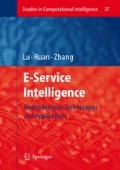Access this chapter
Tax calculation will be finalised at checkout
Purchases are for personal use only
Preview
Unable to display preview. Download preview PDF.
References
L. Kocarev, G. Jakimoski, T. Stojanovski, and Ulrich Parlitz. From chaotic maps to encryption schemes. In Proc. IEEE Int. Symposium Circuits and Systems 98: 4(514-517). IEEE, 1998.
G. Alvarez, G. Pastor F. Monotoya, and M. Romera. Chaotic cryptosystems. In Proc. IEEE Int. Carnahan Conf. Security Technology, pages 332-338. IEEE, 1999.
L. Kocarev. Chaos-based cryptography: A brief overview. IEEE Circuits and Systems Maganize, 1(3):6-21, 2001.
F. Dachselt and W. Schwarz. Chaos and cryptography. IEEE Trans. Circuits and Systems-I, 48(12):1498-1509, 2001.
S.J. Li, Analyses and new designs of digital chaotic ciphers, Ph.D. thesis, School of Electronics and Information Engineering, Xi'an Jiaotong University, Xi'an, China, 2003, available online at http://www.hooklee.com/pub.html.
D.D. Wheeler. Problems with chaotic cryptosystems. Cryptologia, XIII(3):243-250, 1989.
S.J Li, X.Q. Mou, B.L. Yang, Z. Ji and J.H. Zhang, Problems with a Probabilistic Encryption Scheme based on Chaotic Systems, International Journal of Bifurcation and Chaos, vol. 13, no. 10, pp. 3063-3077, 2003
R. Forr´e. The H´enon attractor as a keystream generator. In Advances in Cryptology-EuroCrypt’91, Lecture Notes in Computer Science 0547, pages 76-81, Berlin, 1991. Spinger-Verlag.
H. Zhou and X.T. Ling. Generating chaotic secure sequences with desired statistical properties and high security. Int. J. Bifurcation and Chaos, 7(1):205-213, 1997.
D. D. Wheeler and R. Matthews. Supercomputer investigations of a chaotic encryption algorithm. Cryptologia, XV(2):140-151, 1991.
S.J. Li, X.Q. Mou, and Y.L. Cai. Pseudo-random bit generator based on couple chaotic systems and its application in stream-ciphers cryptography. Progress in Cryptology - INDOCRYPT 2001, Lecture Notes in Computer Science 2247:316-329. Springer-Verlag, Berlin, 2001.
T. Sang, R.L. Wang and Y.X. Yan. Perturbance-based algorithm to expand cycle length of chaotic key stream. Electronics Letters, 34(9):873-874, 1998.
T. Sang, R.L. Wang and Y.X. Yan. Clock-controlled chaotic keystream generators. Electronics Letters, 34(20):1932-1934, 1998.
H.P. Lu and S.H. Wang and X.W. Li and G.N. Tang and J.Y. Kuang and W.P. Ye and G. Hu, A new spatiotemporally chaotic cryptosystem and its security and performance analyses, Chaos, 14(3):617-629, 2004.
G. Tang, S. Wang, H. LÄu, and G. Hu. Chaos-based cryptograph incorporated with S-box algebraic operation. Physics Letters A, 318:388-398, 2003.
K. Kaneko(ed.). Theory and Application of Coupled Map Lattices, chapter 1. John Wiley and Sons, 1993.
A. Lasota and M.C. Mackey. Chaos, Fractals, and Noise: stochastic aspects of dynamics. Spinger-Verlag, 1997.
A.M. Batista and S.E.S. Pinto and R.L. Viana and S.R. Lopes. Lyapunov spectrum and synchronization of piecewise linear map lattiecs with power-law coupling. Physical Review E, 65:056209(9), 2002.
T. Habutsu, Y. Nishio, I. Sasase, and S. Mori. A secret key cryptosystem by iterating a chaotic map. In D.W. Davies, editor, Lecture Notes in Computer Science, volume 547, pages127-140, Brighton, UK, April 1991. Advances in Cryptology - EUROCRYPT '91: Workshop on the Theory and Application of Cryptographic Techniques, Proceeding, Springer-Verlag, Heidelberg.
N. Masuda and K. Aihara. Cryptosystems with discretized chaotic maps. IEEE Trans.Circuits and Systems-I, 49(1):28-40, 2002.
H. Zhou and X.T. Ling. Problems with the chaotic inverse system encryption approach. IEEE Trans. Circuits and Systems-I, 44(3):268-271, 1997.
T. Kohda and A. Tsuneda. Pseudonoise sequence by chaotic nonlinear maps and their correlation properties. IEICE Trans. Commun., E76-B:855-862, 1993.
S.H. Wang, W.R. Liu, H.P. Lu, J.Y. Kuang, and G. Hu. Periodicity of chaotic trajectories in realizations of finite computer precisions and its implication in chaos communications. International Journal of Modern Physics. B, 18(17-19):2617-2622, 2004.
M.Z. Ding and W.M. Yang. Stability of synchronous chaos and on-off intermittency in coupled map lattices. Physical Review E, 6(4):4009-4016, 1997.
J. Xiao, G. Hu, and Z. Qu. Synchronization of spatiotemporal chaos and its application to multichannel spread spectrum communication. Phys. Rev. Lett., 77:4162-4165, 1996.
P. Li, Z. Li, W.A. Halang and G.R. Chen, A Multiple Pseudorandom-Bit Generator Based on a Spatiotemporal Chaotic Map, Phys. Lett. A, 349:.467-473, 2006.
P. Li, Z. Li, W.A. Halang and G.R. Chen, Li-Yorke chaos in a spatiotemporal chaotic system, Chaos, Solitons, and Fractals, in press.
A. Menezes, P.V. Oorschot, and S. Vanstone. Handbook of Applied Cryptography. CRC Press, 1997.
Author information
Authors and Affiliations
Editor information
Editors and Affiliations
Rights and permissions
Copyright information
© 2007 Springer-Verlag Berlin Heidelberg
About this chapter
Cite this chapter
Li, P., Li, Z., Fettinger, S., Mao, Y., Halang, W.A. (2007). Application of Chaos-based Pseudo-Random-Bit Generators in Internet-based Online Payments. In: Lu, J., Zhang, G., Ruan, D. (eds) E-Service Intelligence. Studies in Computational Intelligence, vol 37. Springer, Berlin, Heidelberg. https://doi.org/10.1007/978-3-540-37017-8_31
Download citation
DOI: https://doi.org/10.1007/978-3-540-37017-8_31
Publisher Name: Springer, Berlin, Heidelberg
Print ISBN: 978-3-540-37015-4
Online ISBN: 978-3-540-37017-8
eBook Packages: EngineeringEngineering (R0)

